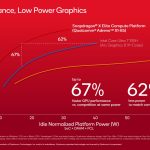In the lead-up to the official launch of the Qualcomm Snapdragon X Elite and Plus processors, Qualcomm has unveiled new details about its graphics architecture. The highly anticipated Adreno X1 marks the first generation of integrated graphics for X-series SoCs running Windows on ARM. The ‘1' denotes the generation, with future iterations set to be named Adreno X2 and so forth. The flagship GPU is the X1-85.
The Adreno X1 GPUs pack up to six shader processors, 1,536 FP32 ALUs, and a remarkable capability to compute 96 texels per cycle. With a peak performance of 4.6 TFLOPS and the ability to process up to 72 gigapixels per second, the Adreno X1 sets an impressive standard for mobile platforms. Supporting all major graphics APIs, including DirectX 12.1 (Shader Model 6.7), DirectX 11, Vulkan 1.3, and OpenCL 3.0, the Adreno X1 GPUs are positioned as a worthy competitor in the integrated graphics segment.
Qualcomm has claimed that the Adreno X1-85 can match or even surpass Intel graphics in many games and consume less power while doing so. However, independent testing and detailed information regarding game settings are still unknown.
Additionally, Qualcomm is set to introduce the Adreno Control Panel, a software that allows users to get the latest game optimisations and driver updates. This move aligns with industry trends observed in larger GPU suppliers and could prove pivotal to the success of the new GPU architecture. The first Qualcomm Snapdragon X laptops are expected to be available starting June 18th.
KitGuru says: Do you think the Qualcomm Snapdragon X series has what it takes to beat Intel and AMD in the laptop market?
 KitGuru KitGuru.net – Tech News | Hardware News | Hardware Reviews | IOS | Mobile | Gaming | Graphics Cards
KitGuru KitGuru.net – Tech News | Hardware News | Hardware Reviews | IOS | Mobile | Gaming | Graphics Cards










